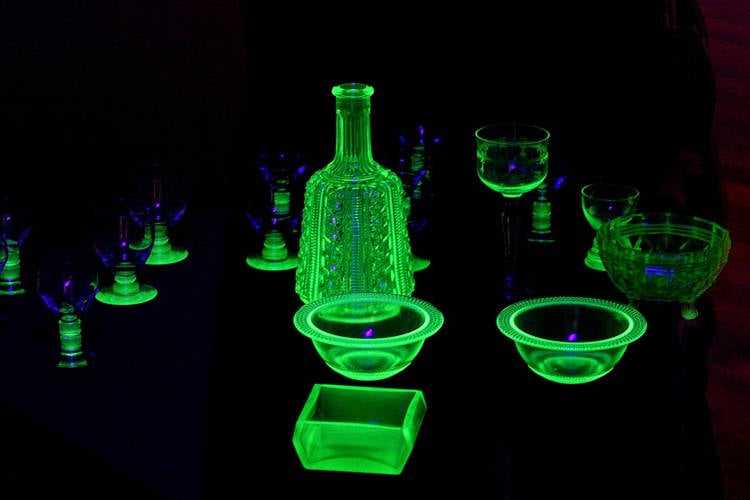Believe it or not, there was once a time when people exposed themselves to harmful levels of radiation to create uranium glass – detailed, fluorescent glassware that glowed a radioactive green under black light. Some antique collectors still live with them in their homes today.
As its name suggests, uranium glass is a special type of glass made with uranium oxide, which gives it a yellow or yellow-green tint, but also makes it radioactive and causes it to glow green under a UV black light. The proportion of uranium in this type of glass usually varies from trace levels to about 2 percent, although uranium glass made in the early twentieth century contained up to 25 percent uranium. Interestingly, the fluorescence of uranium glass is not related to its radioactivity, but is a chemical property of the uranium. In fact, uranium glass is considered generally safe to use, as long as you don’t use it constantly…

Photo: Till Westermeyer/Flickr
The general rule of thumb is to treat uranium glass the same as you would any type pf leaded glass. it’s safe for occasional use, but you shouldn’t actually store foods and drinks in such containers, especially if they are acidic, as these tend to leech out the uranium. Also, you shouldn’t spend more than two hours a day cleaning your collection of uranium glass, especially if the items have a large concentration of uranium.
View this post on Instagram
Radioactive substances in uranium glassware are firmly bound by the glass, which significantly reduces the risk of their spreading into the environment. A uranium glass item with a content of uranium oxides of around 2 percent in emits about 100 μR / h, which makes it safe to use. It’s also worth noting that such items only emit radiation in a range of no more than 10-15 cm, so storing them in a glass case in a residence should pose no considerable health risks.
View this post on Instagram
Interestingly, the higher the concentration of uranium in uranium glass, the less fluorescent it is under black light. In fact, items with over 25 percent uranium oxide content lose their fluorescence completely. While you may be able to recognize some pieces just by looking at them, you need ultraviolet black light to establish whether or not the glass flouresces due to the presence of uranium.
View this post on Instagram
A mosaic found in a Roman villa at Cape Posillipo, in the Gulf of Naples, Italy, which contained pieces of uranium glass with a uranium concentration of 1%, is evidence that this type of glass has been used since ancient times. However, the mass production of uranium glass products in the Late Middle Ages, after the discovery of uranium-containing compounds in the silver mines of the Habsburgs, in Joachimstal, Bohemia. In the 1830s, industrial production began in Bohemia, and for the next century the popularity of uranium glass grew, with various glass blowers and factories around the world using uranium oxide in their wears, to keep up with demand.
View this post on Instagram
The largest number of uranium glass items were produced between the 1880s-1930s, when famous British glass manufacturers like Bagley and Davidson started engraving, etching, and cutting uranium glass into beautiful glass artworks that found a place in the homes of some of the richest and most important people of that era.
View this post on Instagram
But as popular as uranium glass was, the danger it posed primarily during its production could only be ignored for so long. Constant contact with uranium oxides caused enormous harm to the health of glass blowers, and later to that of the workers of large glass-making factories. By the start of World War I, uranium had become a heavily regulated substance, and by the end of the Second World War, uranium production stopped completely.
Deregulation occurred in 1958, but this uranium glass wasn’t the same as the one produced before prohibition. Instead of the radioactive compounds used before, this modern uranium glass was made with depleted uranium. It no longer had the same appeal, and modern uranium never really reached the popularity it once had. However, vintage uranium glassware is still around, and antique collectors routinely buy and sell such items.






